
Take Care of Your Own Body: Restoring Body and Mind Begins in Izu’s Hot Spring Heartland

杉本 練堂
Rendo Sugimoto
Izu [Sizuoka]
Rendo Sugimoto
Born in 1950 in Ito City, Shizuoka Prefecture. In his mid-40s, he became alarmed by the state of the Izu hot spring resort, a popular tourist destination. After suffering a severe leg injury, he further re-evaluated the importance of hot spring therapy. In response, he developed the “Amagi-ryu Hot Spring Therapy” method in Izu to treat illness, injury, and unexplained physical complaints. He is the founder of the NPO Rendojuku and is active both in Japan and internationally as a certified practitioner of Amagi-ryu Hot Spring Therapy.
In Izu, a region renowned for its hot springs, Rendo Sugimoto created “Amagi-ryu Hot Spring Therapy,” based on the belief that "we must protect our own bodies." This self-care method, which involves tuning into one’s own body and adjusting it with one’s own hands, is notable for its ability to bring immediate relief.
Through the blessings of nature, Izu’s hot springs offer a space to reconnect with oneself, promoting healing of both body and mind. We spoke with Sugimoto about how his journey began with a desire to restore his hometown of Izu, not just as a tourist destination, but as a place of true healing.
Izu, Once Again, a Land of Healing for Body and Mind
“People in the Kanto region have long said, ‘Let’s go to Izu for a change of pace.’ It was a place to reset, to clear one’s mind. That’s what Izu used to be.”
Born and raised in this land, Sugimoto devised a self-care method called “Amagi-ryu Hot Spring Therapy” in Izu, a place rich in hot springs. He now travels not only within Japan but around the world to teach it.
Until his mid-40s, Sugimoto ran several French pastry shops. The business was thriving. But one day, while gazing at the Amagi mountain range that towers over his hometown, he began reflecting on Izu’s identity as a hot spring tourist destination.

“When I looked closely, I realized most facilities had nothing to do with hot springs. You could see they were just trying to squeeze money out of tourists. Even though they had this natural gift—hot springs—they were pushing completely unrelated businesses. It made me angry.
At the same time, I had a gut feeling: if this continues, Izu’s tourism is doomed.”
The Izu Peninsula is one of Japan’s top hot spring areas, home to a variety of springs such as Atami, Ito, Atagawa, Shuzenji, and Shimoda. In the past, these places were used for “Toji” – therapeutic stays to recover from fatigue, illness, or injury. Immersing oneself in nature also provided mental rejuvenation.
However, during Japan’s bubble economy era, Izu was reduced to a place focused solely on entertainment.
“The true value and role of hot springs had been completely lost. I wanted to restore Izu as a place where people could reset both their bodies and minds through hot springs.”

Another reason Sugimoto turned his focus to hot springs was his own recovery from a serious injury once deemed untreatable.
“I broke my ankle in a paragliding accident. After surgery, the doctor told me, ‘You’ll never be able to put weight on your heel again.’ I couldn’t accept living like that for the rest of my life.”
Refusing to give up, he began massaging the area in his own way. One day, he tried doing it while soaking in a hot bath—and the pain was significantly reduced.
“I kept massaging in the bath, and after about a month, I could walk on my heel again. I was shocked, but the doctor was even more surprised. That’s when I was reminded of the power of Izu’s hot springs.”
From that point, Sugimoto left his career as a pâtissier and immersed himself in researching hot spring-based self-care. Each time he faced an illness or injury, he turned to hot springs for recovery. Through these experiences, he developed a unique health system combining hot spring therapy with relaxation techniques, breathing methods, chewing practices, and therapeutic touch.
Face Your Body, Understand Yourself, and Heal Yourself

With the guiding belief that “you must protect your own body,” Sugimoto began spreading his self-care method. Early on, it gained attention from government agencies and municipalities, who offered grants and invitations.
“Many public institutions reached out to me as a hot spring therapy advisor. Over time, my work expanded beyond health and healing into tourism and community development.
But I wanted to directly share this method with as many people as possible.”
To do so, he launched a national tour to promote new Toji centers and train instructors. Traveling by car, he held seminars in every prefecture over two years.
“My first message was: face your body and become aware of its current state. Then I would teach methods to care for pain and unexplained symptoms.
The most important point is that you should feel improvement on the spot. Participants would say, ‘The pain is gone!’ and some even forgot their canes when leaving.”
With these firsthand results and growing evidence, Sugimoto’s health method has been compiled into over 25,000 pages of materials. Among his certified instructors are practicing physicians. Many doctors who have struggled with difficult cases themselves now seek out Sugimoto’s teachings, refusing to give up on their patients.
So what exactly are the health benefits of hot springs?
“First, warm water can reduce pain by up to 50%, making it easier to treat injuries or illnesses. Second, it increases joint mobility. Joints that barely moved on land become much more flexible in water.
People with stiff or painful bodies regain movement and begin self-care.”
“People of the past knew this,” Sugimoto says. He believes it’s the duty of hot spring areas to share these benefits with the world.
Living in Harmony With One’s Body, Until the Very End

“The original meaning of the word ‘tourism’ is ‘to observe the light that shines into people’s lives.’ In ancient times, people sought light—symbols of health and longevity—and they arrived at hot springs. That’s why people have long traveled to hot spring resorts.”
Over time, Japan’s hot spring towns, including Izu, lost their deeper significance. But Sugimoto believes their role will become even more crucial in light of future healthcare challenges.
“By 2025, one in three Japanese citizens will be over 65. By 2030, one middle-aged person will support 1.4 seniors. The burden on the healthcare system will be enormous.
That’s why I strongly feel that we must spread the idea of protecting our own health with hot springs before it’s too late.”
Now 75, Sugimoto is deeply aware of the importance of staying healthy as we age.
“Until our final breath, we should try to live in harmony with our bodies. Hot springs are places of healing. If you stay a while, soak in the waters, and reflect on the causes of your pain, you can begin to care for yourself. Life becomes so much easier that way.”
Hot Springs: Nature’s Gift and a Beacon of Life

People continuously visit Izu to receive Sugimoto’s treatments and guidance. His core message is always the same:
Face yourself. Notice your challenges. Live in harmony with nature. Align with the Earth’s rhythm.
“Some people even shed tears just from watching the sunrise. It’s because they became aware of their bodies within nature. They realize how precious their body is.
That moment often sparks a desire to reexamine their way of life. The body and mind are connected. Helping people discover that connection is vital.”
Respect for nature is key.
When the sun shines, be grateful for its warmth. When it rains, appreciate the nourishment. The people of the past lived with this awareness. Healing the body and the mind through hot springs is part of that tradition. These natural gifts are beacons of life—and they have undoubtedly saved many.

We asked Sugimoto what he envisions for the future.
“In recent years, I feel that interest in Amagi-ryu Hot Spring Therapy has grown significantly. As more people suffer from illness, injury, and unexplained symptoms, many are also experiencing for themselves the value of immediate relief.
Looking ahead, I want to establish healing hubs in hot spring regions across Japan—places where people can alleviate physical problems and reduce the impact of aftereffects.
But first, my goal is to restore Izu as a true home for body and mind.”
